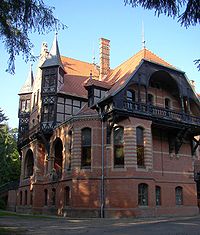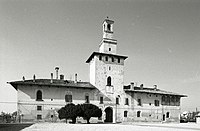
A Jagdschloss is a hunting lodge in German-speaking countries. It is a schloss set in a wildlife park or a hunting area (such as a forest, field or by a lake) that served primarily as accommodation for a ruler or aristocrat and his entourage while hunting in the area.
Characteristics
[edit]
A Jagdschloss was often the venue for a banquet accompanying a hunt, and sometimes it also hosted festivals and other events. The term Jagdschloss is often equated to the Lustschloss or maison de plaisance, particularly as the hunt was also a recreational activity. However, a Lustschloss and Jagdschloss differ in function as well as architecture. The layout and furnishing of a Lustschloss is unconstrained, while that of a Jagdschloss is always related to hunting: the walls may be adorned with antlers and other trophies, with scenes of hunting, and also by a deliberate use of wood or other natural materials.
A Jagdschloss could also be very lavishly furnished, but unlike a Lustschloss, timber-framed buildings or log cabins were not uncommon. Only a few imposing stone buildings have survived, which colours the general understanding of what a Jagdschloss is today. A Jagdschloss often had stables and other outbuildings used to house hunting equipment, coaches and the entourage. Larger examples often form self-contained ensembles, while smaller ones, known as Jagdhäuser, were often built within larger complexes such as castle parks and gardens, within range of the Residenz of the owner.
Surviving Jagdschlösser
[edit]


- Amalienburg in the park of Nymphenburg Palace, Bavaria
- Augustusburg Hunting Lodge in Augustusburg, Saxony
- Baldone Manor in Zemgale, Latvia.
- Clemenswerth in Sögel, Lower Saxony
- Schloss Engers
- Falkenlust in Brühl, North Rhine-Westphalia
- Gelbensande Hunting Lodge
- Glienicke Hunting Lodge
- Göhrde Hunting Lodge
- Granitz Hunting Lodge
- Grünau Hunting Lodge by Neuburg on the Danube
- Grunewald Hunting Lodge in Berlin
- Hubertusstock Hunting Lodge in the Schorfheide
- Jagdschloss Kranichstein in Darmstadt
- Letzlingen Hunting Lodge
- Marshal's Cabin in Loppi, Finland
- Moritzburg Castle in Saxony
- Quitzin Hunting Lodge in Western Pomerania
- Rominten Hunting Lodge
- Springe Hunting Lodge
- Stern Hunting Lodge in Potsdam
- Wolfsgarten Castle in Hesse
- Wolfstein Hunting Lodge in Kochholz
- Schloss Fuschl in Austria
- Schloss Holzheim in Hesse
See also
[edit]Literature
[edit]- Monique Chatenet (ed.): Maisons des champs dans l'Europe de la Renaissance. Actes des premières Rencontres d'architecture européenne, Château de Maisons, 10-13 juin 2003. Picard, Paris, 2006, ISBN 2-7084-0737-6, (De Architectura 11).
- Claude d'Anthenaise (ed.): Chasses princières dans l'Europe de la Renaissance. Actes du colloque de Chambord (1er et 2 octobre 2004). Fondation de la Maison de la Chasse et de la Nature. Actes Sud, Arles, 2007, ISBN 978-2-7427-6643-7.
- Heiko Laß: Jagd- und Lustschlösser: Art and culture of two sovereign construction tasks; shown in Thuringian constructions of the 17th and 18th century. Imhof, Petersberg, 2006, ISBN 3-86568-092-5
Well, that’s interesting to know that Psilotum nudum are known as whisk ferns. Psilotum nudum is the commoner species of the two. While the P. flaccidum is a rare species and is found in the tropical islands. Both the species are usually epiphytic in habit and grow upon tree ferns. These species may also be terrestrial and grow in humus or in the crevices of the rocks.
View the detailed Guide of Psilotum nudum: Detailed Study Of Psilotum Nudum (Whisk Fern), Classification, Anatomy, Reproduction